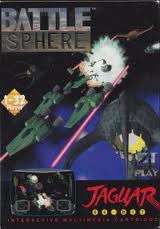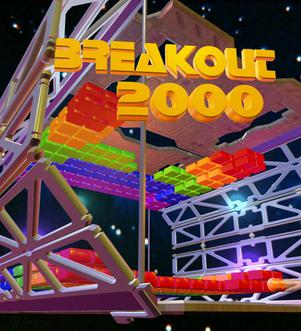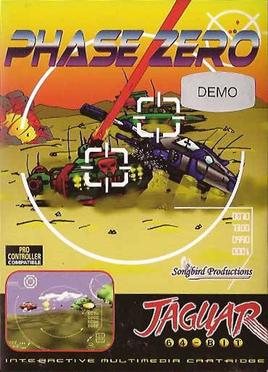
Graham Gooch World Class Cricket is a cricket video game developed and published by Audiogenic in 1993. It is endorsed by former England cricketer Graham Gooch and is available for the Amiga and PC computer systems.

Soulstar is a hybrid rail shooter/third-person shooter video game developed and originally published by Core Design for the Sega CD in Europe in April 1994, then in North America by Time Warner Interactive in September, and later in Japan by Victor Entertainment on December 22.

Ultra Vortek is a fighting game developed by Beyond Games and published by Atari Corporation for the Atari Jaguar in North America and Europe on September 5, 1995. It was the second fighting game released for the Jaguar after Kasumi Ninja and unsuccessfully sought to capitalize on the trend of violent fighting games started by Midway Games's Mortal Kombat in 1992. It was the only officially released game that supports the unreleased Jaguar Voice Modem peripheral for online play.

Defender 2000 is a side-scrolling shoot 'em up video game developed by Llamasoft and published by Atari Corporation for the Atari Jaguar on December 1995. Part of Atari Corp.'s 2000 series, it is a remake by Jeff Minter of Eugene Jarvis and Larry DeMar's 1981 arcade game Defender, which drew inspiration from Space Invaders and Asteroids.

BattleSphere is a first-person space combat simulation video game originally developed by 4Play and published by ScatoLOGIC exclusively for the Atari Jaguar on February 29, 2000.

Baldies is a 1995 real-time strategy video game developed by Creative Edge Software and originally published by Atari Corporation for the Atari Jaguar CD. It was later ported to PC, PlayStation, and Sega Saturn. In the game, the player manages a community of Baldies in order to build structures, increase their population, and create weapons to fight against enemies known as Hairies. There are four classes of Baldies and each structure has specific properties to assist the player. Its gameplay combines strategy with simulation and god game elements. Up to four players can participate in a multiplayer mode via local area network (LAN) on PC.

Iron Soldier is an open world first-person mecha simulation video game developed by Eclipse Software Design and published by Atari Corporation for the Atari Jaguar in North America and Europe on December 22, 1994, then in Europe in January 1995 and later in Japan on March 24 of the same year, where it was instead published by Mumin Corporation. The first installment in the eponymous franchise, the game is set in a dystopian future where industries and machinery has overrun most of the surface on Earth, as players assume the role of a resistance member taking control of the titular mech in an attempt to overthrow the dictatorship of Iron Fist Corporation, who have conquered the world through usage of military force.

Battlemorph is a 1995 shooter video game developed by Attention to Detail (ATD) and published by Atari Corporation for the Atari Jaguar CD. It is the sequel to Cybermorph (1993), a pack-in game for the Atari Jaguar. Taking place 30 years after the events of the original game, the player pilots the morphing infiltration fighter War Griffon in an extermination mission against the Pernitia empire, who plans to launch a full-scale invasion to eradicate humanity and take over the galaxy after being pushed back into their home planet. The player is tasked with various objectives, while fighting against enemies and bosses, across eight galaxy clusters in order to liberate them from control of the empire.

Val d'Isère Skiing and Snowboarding is a skiing and snowboarding video game developed by Virtual Studio and published by Atari Corporation for the Atari Jaguar first in North America on December 9, 1994. It was later released in Europe in January 1995 and finally in Japan on July of the same year, where it was published by Messe Sansao. It is a conversion of the SNES title Tommy Moe's Winter Extreme: Skiing & Snowboarding, which was done by the same team at Loriciels and released in 1994 on all regions.

Zero-5 is a shooter video game developed and published by Caspian Software for the Atari STe in 1994. It is one of the last official releases for the Atari ST after being discontinued in 1993 by Atari Corporation.

AirCars is a 1997 shooter video game developed by MidNite Entertainment Group Inc., published in North America by ICD and in France by La Terre du Milieu for the Atari Jaguar. It was one of the last officially licensed releases for the platform. The game follows a government pilot controlling an aircar to stop the E.B.N.E.R.S. organization, which plans to dominate a post-apocalyptic world left by a nuclear holocaust. The player fights against enemies and bosses, while shooting down key targets across 32 missions set on various locations. Two players can also play the main campaign or up to eight players can participate in a deathmatch mode.

World Tour Racing is a Formula One racing video game developed by Teque London and published by Telegames exclusively for the Atari Jaguar CD on June 2, 1997. It is the spiritual successor to F1 Licenceware's 1994 Amiga game F1-Racer and one of the last licensed titles for the add-on after being discontinued in 1996 by Atari Corporation, who merged with JT Storage in a reverse takeover prior to launch.

Skyhammer is a shooter video game developed by Rebellion Developments and published by Songbird Productions for the Atari Jaguar on May 22, 2000. Its gameplay style is reminiscent of Psygnosis' G-Police for the PlayStation, which was released three years prior to the game.

Power Drive Rally is a racing video game developed by Rage Software and published by Time Warner Interactive for the Atari Jaguar in North America and Europe in 1995. It was also published in Japan by Messe Sansao on the same year. It is the sequel to Power Drive, which was released earlier in 1994 on multiple platforms.

Breakout 2000 is a 1996 action video game developed by MP Games and published by Telegames for the Atari Jaguar. Part of the 2000 series by Atari Corporation, it is a remake of the arcade game Breakout (1976), and one of the last officially licensed releases for the platform. Featuring a similar premise, the player must destroy a layer of brick lines by repeatedly bouncing a ball spawned off a paddle into them and keep it in play. It modifies the gameplay of the original game, introducing a third-person perspective behind the paddle in a pseudo-3D playfield, power-ups, bonus levels, enemies, varying level designs, and multiplayer.

Towers II: Plight of the Stargazer is a first-person role-playing video game originally developed and published by JV Enterprises for the Atari Falcon in 1995. It is the sequel to Towers: Lord Baniff's Deceit, which was first released as a shareware title on the Atari ST in 1993 and later ported to MS-DOS and Game Boy Color.

Hover Strike: Unconquered Lands is a shooter video game developed and published by Atari Corporation exclusively for the Atari Jaguar CD in North America and Europe on October 23, 1995. A remake of Hover Strike for the Atari Jaguar, it was created by most of the original team who worked on the original game and both titles share the same overall plot, where the Terrakian alien race seized control of a colonized foreign planet and players are tasked with piloting an armed hovercraft vehicle in an attempt of rescuing the captured colonists and destroy the invading forces from the planet's surface before the Federation armada arrives.

Iron Soldier 2 is an open world first-person mecha simulation video game developed by Eclipse Software Design and published by Telegames for the Atari Jaguar and Atari Jaguar CD on December 30, 1997. It is the sequel to Iron Soldier.

Iron Soldier 3 is an open world first-person mecha simulation video game developed by Eclipse Software Design and originally published by Vatical Entertainment for the PlayStation on 20 June 2000 and was ported to the Nuon in 2001. A sequel to Iron Soldier 2, it is the third and last installment of the Iron Soldier series.

Phase Zero is an unreleased action-shooter video game that was in development by Hyper Image Productions and originally planned to be published by Atari Corporation on a scheduled September 1995 release date exclusively for the Atari Jaguar. It was the only game in development by Hyper Image.
























